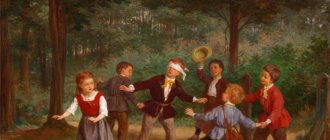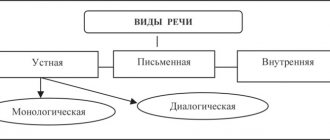Oral folk art as a means of speech development for children of primary preschool age
Oral folk art as a means of speech development
children of primary preschool age.
Katasonova N.I., teacher
MBDOU "CRR - kindergarten No. 22" Livny
In the 21st century, modern society widely uses technical means of communication, such as telephone communications, television and, of course, the Internet. And the high preoccupation of parents with everyday family problems greatly reduced the quality of communication between the child and the adult. This led to the emergence of various problems in the formation of communicative behavior of the younger generation. But the development of speech is inextricably linked with the formation of both the personality as a whole and all mental processes.
Thus, the problem of speech development of a preschool child becomes the most pressing. But how can this problem be solved effectively, especially when it comes to preschool age? And here the teacher comes to the aid of oral folk art. The brilliant creator of language and the greatest teacher - the people created such works of artistic expression that lead the child through all stages of his development.
Oral folk art is a special type of art that includes a large number of genres. Fairy tales, proverbs and sayings, ditties, chants and nursery rhymes, lullabies are the invaluable wealth of the Russian people. It is with the help of oral folk art that a child masters his native language, its melody, then the ability to understand its meaning, masters its beauty, laconicism, gaining ideas about the culture of his people. The entire centuries-old experience of the people and folk morality are concentrated in oral folk art. It contains a huge amount of information and establishes continuity between the past and the present. In no other works, except folk ones, will you find such an ideal arrangement of difficult-to-pronounce sounds, such an amazingly thoughtful combination of words that barely differ from each other in sound.
In works of oral folk art we see an abundance of words-attributes of objects, figurative comparisons, synonyms, antonyms. First, the child copies the movements and intonations with which the lullaby is sung, and then the words appear. At the same time, surprisingly quickly, many words of songs pass into the active vocabulary of children and are heard already during games and conversations with peers. Thus, lullabies contribute to the development of phonemic awareness. They enrich children’s vocabulary due to the fact that they contain a wide range of information about the world around them, primarily about those objects that are close to people’s experience and attract with their appearance, for example, “bunny”, “fox”, “top”. The grammatical variety of lullabies helps to master the grammatical structure of speech. I teach children to form words with the same root, as they create images that are well known to children, for example, the image of a cat. Moreover, this is not just a cat, but “kitten-cat”, “cat-white belly”, “cat”, “kitty”. In addition, positive emotions associated with one thing or another in a familiar way from the cradle make this development more successful and lasting. In lullabies, the role of improvisation is great: they are sung until the child falls asleep. At the same time, traditional, stable texts are of great importance. Nursery rhymes and pestushki are games with plot elements, games (“Ladushki, ladushki...”, “The horned goat is coming...”). Listings and dialogues appear in them. As in lullabies, rhythm is important in pestushki. A cheerful, intricate song with a clear chant of poetic lines puts a child in a joyful mood.
We also use various jokes for the speech development of younger preschoolers. These are songs or rhymes that captivate the child with their content. The plots of the jokes are very simple (single-motive or cumulative), reminiscent of “little fairy tales in verse” (V.P. Anikin). The jokes contain the first edifications: a stubborn goat is eaten by wolves; The little kitty didn’t leave the butter to treat the other... That is, they contain a lot of colorful and vivid verbal pictures, which allows you to enrich children’s vocabulary. Listening to them frequently helps preschoolers learn new forms of words for objects. The accumulation of such speech samples further contributes to the transition to linguistic generalizations. Reading jokes and nursery rhymes occurs with many repetitions, where individual words, phrases, sentences and even quatrains are repeatedly pronounced. All this contributes to memorizing words and then actively using them. Another value of nursery rhymes and jokes is that the word is connected to the child’s action. Their content is rich in verbs. Using them, the teacher demonstrates actions indicated by words, thereby connecting the word itself with the action. Calls and sentences play an important role in speech development. These are genetically the most ancient forms of children's verbal games. By origin they are associated with the calendar rituals of adults. Oral sentences also passed from adults into children's lives. These are short, usually poetic appeals to animals and birds, ladybug, bees; to the mouse with a request to replace the old, fallen tooth with a new, strong one; to the hawk so that it doesn’t circle over the house and look out for chickens. Calls are songs addressed to nature (sun, rain, rainbow) and expressing a call or request. The content of the chants is close to the concerns and aspirations of farmers: the need for rain or, on the contrary, sunshine.
The chants are shouted out in chorus, in a chant. In contrast, sentences are pronounced individually and quietly. Their content includes a request-conspiracy addressed to a snail, ladybug, mouse... This contributes to the development of monologue and dialogic speech. And children develop their organs of articulation in tongue twisters, which require the repetition of difficult to pronounce words. In the process of organizing various types of activities with children, I use proverbs and sayings in my speech, since they are figurative, poetic, endowed with comparisons, vivid epithets, they contain a lot of personifications and small definitions. Children's understanding of proverbs and sayings depends on the degree of their allegory. They are not always clear to children and require clarification. It is necessary to use proverbs in the context of activity under appropriate conditions, which will make their meaning clear. Proverbs and sayings are pronounced expressively, with different intonations (with surprise, condemnation, regret, joy, satisfaction, affirmation, etc.), and are also accompanied by facial expressions and gestures. Expressive intonation and gestures help to understand the essence of the proverb and encourage children to take the desired action. This also helps children overcome difficulties in constructing free-form phrases when expressing their thoughts.
Every child, of course, enjoys a great love for fairy tales. From a very early age, a child gets acquainted with a fairy tale told by his mother or grandmother, and experiences certain feelings and experiences. Folk tales contain invaluable content. Thus, in relation to the saturation of artistic speech with linguistic means of expressiveness - epithets, comparisons, synonyms, antonyms, etc. (for example, clear falcon, beautiful maiden, stand in front of me like a leaf in front of the grass). A fairy tale allows children to clarify and expand their vocabulary, teaches them to use particles and prepositions in speech, develops practical skills in word formation and inflection, and teaches them to use simple sentences in speech. All this is the basis for the successful development of a child’s coherent speech with the coordination of words in a sentence in gender, number, case, and tense.
Imagery is an important feature of fairy tales, which facilitates their perception by children who are not yet capable of abstract thinking. The fun nature of fairy tales increases children's interest in them. Didacticism is one of the most important features of fairy tales of all peoples of the world. These features of fairy tales make it possible to use them in solving pedagogical problems. A child’s journey into the world of a fairy tale develops children’s imagination, fantasy, and encourages them to write. Children brought up on the best literary examples in the spirit of humanity show themselves to be fair in their stories and fairy tales, protecting the offended and weak and punishing the evil. Children should derive both aesthetic and especially moral (ethical) ideas from works of art, and not from the moralizing arguments of teachers about the works they read.
Ushinsky gave an exhaustive assessment of the tale, saying: “These are the first and brilliant attempts of Russian folk pedagogy, and I don’t think that anyone would be able to compete in this case with the pedagogical genius of the people. A folk tale is easy for children to read simply because in all folk tales the same words and phrases are constantly repeated, and from these incessant repetitions, which perfectly satisfy the pedagogical meaning of the story, something whole, harmonious, easily perceptible, full of movement and life is formed and interest."
Thus, the use of oral folk art in organizing various types of children's activities allows me, as a teacher, to solve the problems of speech development of children of primary preschool age, making the process itself exciting and natural for kids. But not a single task can be effectively solved without the participation of parents. Therefore, I try to convey to them the importance of using folk art in family communication, develop and maintain interest in oral folk art. After all, only joint efforts to create favorable conditions for children to master the language of folk art that is accessible to them can have a huge educational and developmental impact on a preschool child.
Bibliography
1. Big book of Russian folk tales. - M.: Makhaon, 2010. - 176 p.
2. Budarina T.A., Korepanova O.N., Kuprina L.S., Markeeva O.A. Introducing children to Russian folk art. - M.: Detstvo-Press, 2010. - 400 p.
3. Gavrilova I.G. The origins of Russian folk culture in kindergarten. - St. Petersburg: Detstvo-Press, 2010. - 160 p.
4. V.V. Gerbova Speech development in kindergarten. Junior group. For classes with children 3-4 years old. Federal State Educational Standard
5. Dmitrieva V. 1000 poems, counting rhymes, tongue twisters, proverbs for reading at home and in kindergarten. - M.: Astrel, Poligrafizdat, Sova, 2012. - 496 p.
6. Kapitsa F.S., Kolyadich T.M. Russian children's folklore: Textbook. allowance. - M.: Flinta, 2002. - 320 p.



